Honda CR-V: Engine Installation
Special Tools Required
- Universal eyelet 07 AAK-SNAA 120
- Engine hanger adapter VSB02C000015 *
- Front subframe adapter VSB02C000016 *
- CR-V engine hanger adapter VSB02C000032 *
- Engine support hanger, A and Reds AAR-T-12566 *
* : Available through American Honda Tool and Equipment Program, 1-888-424-6857
1. Install the accessory brackets, and tighten their bolts to the specified torques.

2. Raise the vehicle on the lift, and position the engine /transmission assembly under the vehicle. Lower the vehicle, and attach the special tool and chain hoist to the engine, then lift the engine into position in the vehicle.
NOTE: Reinstall the mounting bolts and support nuts in the sequence given in the following steps.
Failure to follow this sequence may cause excessive noise and vibration, and reduce engine mount life.

3. Attach the special tool adapter (VSB02C000015) to the threaded hole (A) in the cylinder head.

4. Remove both lids (A) from the cowl cover. Position the engine hanger adapters (VSB02C000032) over the damper flange nuts.

5. Install the engine support hanger (AAR-T-12566), then attach the hook to the slotted hole in the hanger adapter. Tighten the wing nut (A) by hand to lift and support the engine/transmission assembly.
NOTE: Be careful when working around the windshield.

6. Loosen the upper torque rod mounting bolt (A).

7. Tighten the new side engine mount bracket mounting bolt and nut.
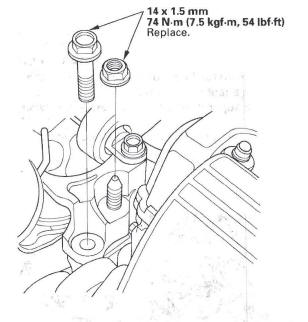
8. Remove the chain hoist.
9. Remove the universal eyelet.
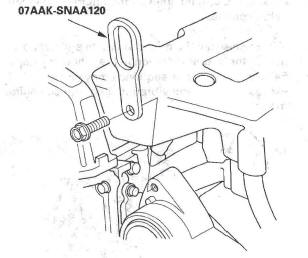
10. Remove the transmission hanger bracket (P/N 21232-RCT-AOO) (A) and washer (B).

11. Install the transmission mount bracket (A) then install the ground cable (B).
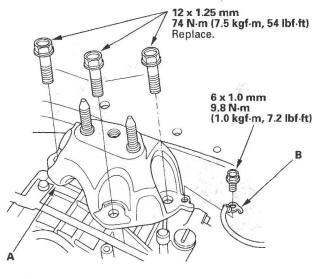
12. Install the transmission mount, then tighten the transmission mount stiffener mounting bolts (A) and the new transmission mount mounting bolts (B).
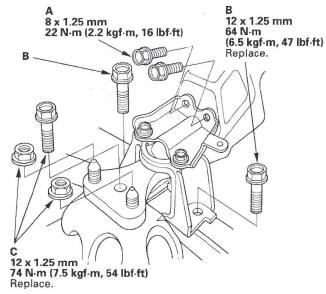
13. Tighten the new bolt and nuts (C).
14. Raise the vehicle on the lift to full height.
15. Using the subframe adapter (A) and a jack, raise the subframe up to body.

16. Loosely install the new 14 x 1.5 mm bolts.

17. Align all reference marks (A) on the front subframe (B) with the body, then tighten the bolts on the front subframe to the specified torque.

18. Tighten the new subframe mounting bolts (A) on both side.

19. Install the lower torque rod, then tighten the new lower torque rod mounting bolts in the numbered sequence shown.

20. Lower the vehicle on the lift.
21. Remove the engine support hanger from the vehicle. Remove the adapter from the cylinder head.
22. Tighten the upper torque rod mounting bolt.

23. Raise the vehicle on the lift to full height.
24. Install the A/C compressor (A), then connect the A/C compressor clutch connector (B).

25. Install the bolts securing the left steering gearbox mounting bracket.

26. Install the bolts securing the right steering gearbox mounting bracket.

27. Install the power steering (P/S) fluid line bracket (A), and secure the hose with the hose clamps (B).

28. Install the propeller shaft.
29. Install a new set ring on the end of each driveshaft, then install the driveshafts. Make sure each ring "clicks" into place in the differential and intermediate shaft.
30. Connect the lower arms to the knuckles (see step 8).
31. Install the shift cable (see step 34).
32. Install the three way catalytic converter (TWC) (A).
Use new gaskets (B) and new self-locking nuts (C).

33. Connect the air fuel ratio (A/F) sensor connector (D) and secondary heated oxygen sensor (secondary HO2S) connector (E).
34. Install the splash shield.

35. Lower the vehicle on the lift.
36. Install the heater hoses.

37. Install the radiator.
38. Install the automatic transmission fluid (ATF) cooler hose (A), and secure the hoses with the clip (B).

39. Install the P/S pump (A), then install the P/S hose to the clamp (B).

40. Install the drive belt.
41. Connect the fuel feed hose, then install the quick-connect fitting cover (A).
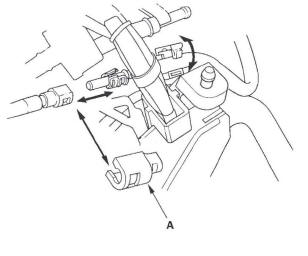
42. Install the evaporative emission (EVAP) canister hose (A) and brake booster vacuum hose (B).

43. Install the powertrain control module (PCM) bracket (A), then install the harness clamp (B).

44. Connect the PCM connectors (A) and engine wire harness connector (B).

45. Install the harness clamps (C).
46. Install the PCM (A), then install the PCM cover (B).

47. Install the battery cables (A) to the under-hood fuse/relay box.

48. Connect the harness connector (B), and install the harness clamp (C).
49. Install the ground cable (A) and harness clamp (B).

50. Install the air cleaner housing assembly.
51. Install the front wheels.
52. Install the battery. Clean the battery posts and cable terminals with a battery post cleaner, then assemble them, and apply grease to prevent corrosion.
53. Move the shift lever to each gear, and verify that the A/T gear position indicator follows the transmission range -switch.
54. Inspect for fuel leaks: Turn the ignition switch ON (II) (do not operate the starter) so the fuel pump runs for about 2 seconds and pressurizes the fuel line. Repeat this operation two or three times, then check for fuel leakage at any point in the fuel line.
55. Refill the engine with engine oil (see step 4).
56. Refill the transmission with ATF (see step 3).
57. Refill the radiator with engine coolant, and bleed air from the cooling system with the heater valve open (see step 6).
58. Do the PCM reset procedure.
59. Do the crankshaft position (CKP) pattern clear/CKP pattern learn procedure.
60. Inspect the idle speed.
61. Inspect the ignition timing.
62. Check the wheel alignment.
63. Enter the anti-theft code for the audio system and the navigation system (if equipped), then enter the MX radio presets.
64. Set the clock.

